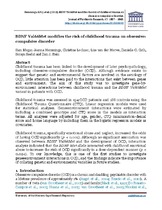| dc.contributor.author | Hemmings, Sian Megan Joanna | |
| dc.contributor.author | Lochner, Christine | |
| dc.contributor.author | van der Merwe, Lize | |
| dc.contributor.author | Cath, Danielle C. | |
| dc.contributor.author | Seedat, Soraya | |
| dc.contributor.author | Stein, Dan J. | |
| dc.date.accessioned | 2018-01-26T13:20:40Z | |
| dc.date.available | 2018-01-26T13:20:40Z | |
| dc.date.issued | 2013 | |
| dc.identifier.citation | Hemmings, S.M.J. et al. (2013). BDNF Val66Met modifies the risk of childhood trauma on obsessive-compulsive disorder. Journal of Psychiatric Research, 47: 1857 – 1863. | en_US |
| dc.identifier.issn | 0022-3956 | |
| dc.identifier.uri | http://dx.doi.org/10.1016/j.jpsychires.2013.08.012 | |
| dc.identifier.uri | http://hdl.handle.net/10566/3425 | |
| dc.description.abstract | Childhood trauma has been linked to the development of later psychopathology, including obsessive-compulsive disorder (OCD). Although evidence exists to suggest that genetic and environmental factors are involved in the aetiology of OCD, little attention has been paid to the interactions that exist between genes and environment. The aim of this study was to investigate gene-by-environment interactions between childhood trauma and the BDNF Val66Met variant in patients with OCD.
Childhood trauma was assessed in 134 OCD patients and 188 controls using the Childhood Trauma Questionnaire (CTQ). Linear regression models were used for statistical analyses. Geneeenvironment interactions were estimated by including a combined genotype and CTQ score in the models as interaction terms. All analyses were adjusted for age, gender, CTQ minimisation-denial score and home language by including them in the logistic regression models as covariates.
Childhood trauma, specifically emotional abuse and neglect, increased the odds of having OCD significantly (p < 0.001). Although no significant association was observed between BDNF Val66Met and the development of OCD, interaction analysis indicated that the BDNF Met-allele interacted with childhood emotional abuse to increase the risk of OCD significantly in a dose-dependent manner (p < 0.024). To our knowledge, this is one of the first studies to investigate geneeenvironment interactions in OCD, and the findings indicate the importance of collating genetic and environmental variables in future studies. | en_US |
| dc.language.iso | en | en_US |
| dc.publisher | Elsevier | en_US |
| dc.rights | This is the author-version of the article published online at: http://dx.doi.org/10.1016/j.jpsychires.2013.08.012 | |
| dc.subject | Obsessive-compulsive disorder (OCD) | en_US |
| dc.subject | Geneeenvironment interaction | en_US |
| dc.subject | Childhood trauma | en_US |
| dc.subject | CTQ | en_US |
| dc.subject | Brain-derived neurotrophic factor | en_US |
| dc.title | BDNF Val66Met modifies the risk of childhood trauma on obsessive-compulsive disorder | en_US |
| dc.type | Article | en_US |
| dc.privacy.showsubmitter | FALSE | |
| dc.status.ispeerreviewed | TRUE | |
| dc.description.accreditation | Web of Science | |

